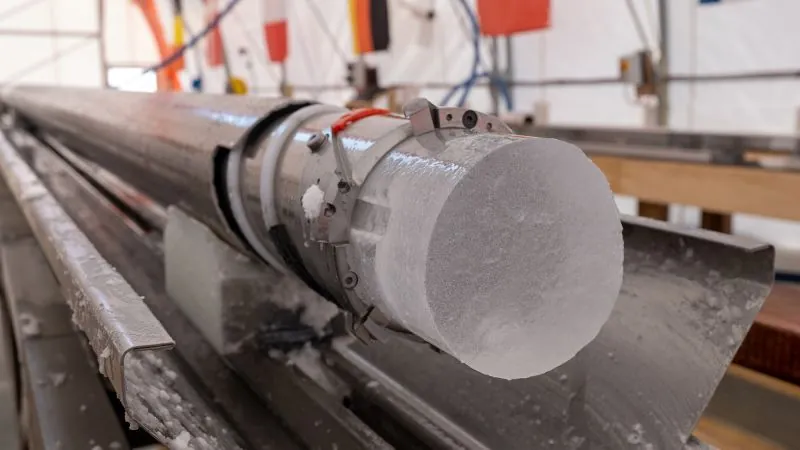
Groundbreaking Antarctic Ice Core Discovery Could Unlock Secrets of Ancient Climate Changes
2025-01-11
Author: Amelia
Groundbreaking Antarctic Ice Core Discovery Could Unlock Secrets of Ancient Climate Changes
An international research team has achieved a remarkable feat by drilling a 9,186-foot-long (2,800-meter-long) ice core from the frigid expanse of Antarctica, dating back an astonishing 1.2 million years. This monumental achievement not only extends our climate history but taps into the very bedrock beneath the Antarctic Ice Sheet.
Carlo Barbante, the project coordinator for the European Project for Ice Coring in Antarctica (Beyond EPICA), referred to this ice core as a “time machine,” offering an extraordinary archive of Earth’s climatic shifts. The core measures nearly the length of 25 soccer fields lined up in a row or is, to put it in perspective, six and a half times taller than the Empire State Building, antenna included.
Representatives from 12 leading European scientific institutions have collaborated on this fourth campaign of the Beyond EPICA project, which took place during the Antarctic summer between mid-November and mid-January. Experts have spent over 200 days over the last four summers on drilling, processing, and analyzing this ancient ice.
Ice Insights from a Harsh Environment
The ice core was extracted from Little Dome C, one of the globe's most extreme environments, situated 21 miles (34 kilometers) from the Italian-French Concordia research station. Here, relentless winds and temperatures that dip below minus 40 degrees Fahrenheit (minus 40 degrees Celsius) create a challenging atmosphere for research.
Barbante noted that the air bubbles trapped within the ice provide a direct snapshot of the past atmospheric composition, offering crucial data on greenhouse gas concentrations, such as carbon dioxide and methane. Analyzing these elements helps scientists reconstruct how Earth’s climate has responded to varying climate forces like solar fluctuations, volcanic activities, and orbital cycles over hundreds of thousands of years—and now, extending back to 1.2 million years.
A significant research aim is to uncover the mystery surrounding the abrupt shifts in Earth's ice ages roughly 1 million years ago. This event nearly led to the extinction of ancient human ancestors, a pressing issue reflected in recent research findings.
Tracing Ancient Climate Cycles
The original EPICA project, conducted from 1996 to 2008, identified a significant 100,000-year cycle of ice ages punctuated by warmer interludes in the last 800,000 years of climate history. However, sediments revealed that prior to 1 million years ago, Earth's conditions fluctuated in a 41,000-year cycle. This inconsistency fueled the launch of the Beyond EPICA project in 2016, which set out to find older ice that could shine a light on why these climate cycles transitioned so dramatically.
Drilling at Little Dome C required meticulous planning to avoid loss of data due to potential ice melting from Earth's internal heat. Dr. Robert Mulvaney, a glaciologist with the British Antarctic Survey, expressed the importance of selecting a “Goldilocks site”—not too thick nor too thin to ensure the preservation of ancient layers.
Unlocking an Ice Age Mystery
Upon retrieval, the core revealed its worth, with the bottom 688 feet (210 meters) comprised of ancient, heavily deformed ice. Researchers are now tasked with determining whether this ice could lead to the discovery of even older layers, possibly from the pre-Quaternary period—providing critical information on the timing when this region last experienced a thaw.
As the team delves into these ancient layers, they expect to uncover vital insights about the Mid-Pleistocene Transition, a pivotal period characterized by an extended ice age phase and significant temperature drops. This era brought human ancestral populations dangerously close to extinction, a claim supported by studies suggesting only about 1,280 individuals survived during a critical period around 930,000 years ago.
Understanding atmospheric conditions during these ancient transitions has never been more urgent. Ice cores, often described as nature’s Rosetta Stones, retain layered records that denote temperature shifts and gas concentrations. Jim White from the University of North Carolina noted the value of these insights into Earth’s past climate, emphasizing the potential implications for future climate predictions.
Looking Ahead: The Quest for Older Ice
After preliminary analyses on-site, the core samples will be transported to Europe aboard the icebreaker ship Laura Bassi in insulated containers to maintain stable temperatures. This multiyear endeavor promises to deepen our understanding of climate dynamics and could illuminate the conditions that led to major historical climate shifts.
As the Beyond EPICA project continues, researchers will search for other locations in Antarctica that could yield similar ancient climate records, underscoring the ongoing quest to unearth deeper truths about our planet's climatic past. The findings from this groundbreaking project may redefine our understanding of climate change and its impacts on both past and present human existence.









 Brasil (PT)
Brasil (PT)
 Canada (EN)
Canada (EN)
 Chile (ES)
Chile (ES)
 Česko (CS)
Česko (CS)
 대한민국 (KO)
대한민국 (KO)
 España (ES)
España (ES)
 France (FR)
France (FR)
 Hong Kong (EN)
Hong Kong (EN)
 Italia (IT)
Italia (IT)
 日本 (JA)
日本 (JA)
 Magyarország (HU)
Magyarország (HU)
 Norge (NO)
Norge (NO)
 Polska (PL)
Polska (PL)
 Schweiz (DE)
Schweiz (DE)
 Singapore (EN)
Singapore (EN)
 Sverige (SV)
Sverige (SV)
 Suomi (FI)
Suomi (FI)
 Türkiye (TR)
Türkiye (TR)
 الإمارات العربية المتحدة (AR)
الإمارات العربية المتحدة (AR)